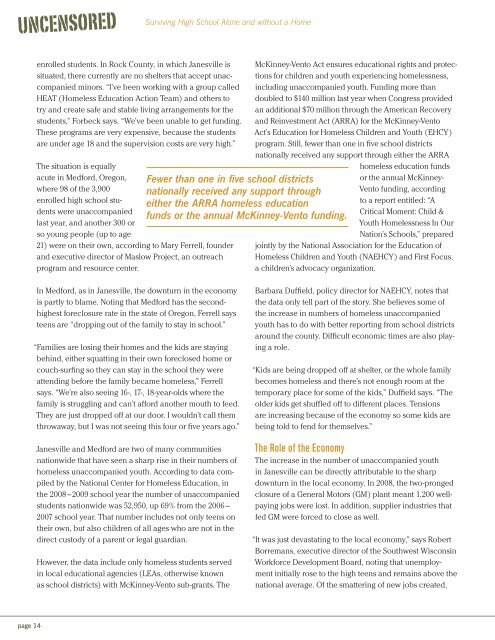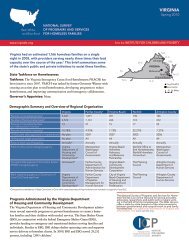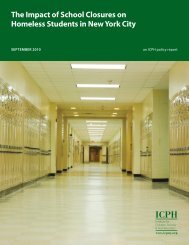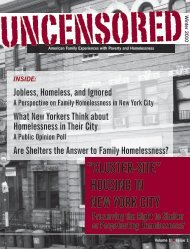UNCENSORED, American Family Experiences with Poverty and ...
UNCENSORED, American Family Experiences with Poverty and ...
UNCENSORED, American Family Experiences with Poverty and ...
- No tags were found...
Create successful ePaper yourself
Turn your PDF publications into a flip-book with our unique Google optimized e-Paper software.
<strong>UNCENSORED</strong>Surviving High School Alone <strong>and</strong> <strong>with</strong>out a Homeenrolled students. In Rock County, in which Janesville issituated, there currently are no shelters that accept unaccompaniedminors. “I’ve been working <strong>with</strong> a group calledHEAT (Homeless Education Action Team) <strong>and</strong> others totry <strong>and</strong> create safe <strong>and</strong> stable living arrangements for thestudents,” Forbeck says. “We’ve been unable to get funding.These programs are very expensive, because the studentsare under age 18 <strong>and</strong> the supervision costs are very high.”The situation is equallyacute in Medford, Oregon,where 98 of the 3,900enrolled high school studentswere unaccompaniedlast year, <strong>and</strong> another 300 orso young people (up to age21) were on their own, according to Mary Ferrell, founder<strong>and</strong> executive director of Maslow Project, an outreachprogram <strong>and</strong> resource center.Fewer than one in five school districtsnationally received any support througheither the ARRA homeless educationfunds or the annual McKinney-Vento funding.McKinney-Vento Act ensures educational rights <strong>and</strong> protectionsfor children <strong>and</strong> youth experiencing homelessness,including unaccompanied youth. Funding more th<strong>and</strong>oubled to $140 million last year when Congress providedan additional $70 million through the <strong>American</strong> Recovery<strong>and</strong> Reinvestment Act (ARRA) for the McKinney-VentoAct’s Education for Homeless Children <strong>and</strong> Youth (EHCY)program. Still, fewer than one in five school districtsnationally received any support through either the ARRAhomeless education fundsor the annual McKinney-Vento funding, accordingto a report entitled: “ACritical Moment: Child &Youth Homelessness In OurNation’s Schools,” preparedjointly by the National Association for the Education ofHomeless Children <strong>and</strong> Youth (NAEHCY) <strong>and</strong> First Focus,a children’s advocacy organization.In Medford, as in Janesville, the downturn in the economyis partly to blame. Noting that Medford has the secondhighestforeclosure rate in the state of Oregon, Ferrell saysteens are “dropping out of the family to stay in school.”“Families are losing their homes <strong>and</strong> the kids are stayingbehind, either squatting in their own foreclosed home orcouch-surfing so they can stay in the school they wereattending before the family became homeless,” Ferrellsays. “We’re also seeing 16-, 17-, 18-year-olds where thefamily is struggling <strong>and</strong> can’t afford another mouth to feed.They are just dropped off at our door. I wouldn’t call themthrowaway, but I was not seeing this four or five years ago.”Janesville <strong>and</strong> Medford are two of many communitiesnationwide that have seen a sharp rise in their numbers ofhomeless unaccompanied youth. According to data compiledby the National Center for Homeless Education, inthe 2008 –2009 school year the number of unaccompaniedstudents nationwide was 52,950, up 69% from the 2006 –2007 school year. That number includes not only teens ontheir own, but also children of all ages who are not in thedirect custody of a parent or legal guardian.However, the data include only homeless students servedin local educational agencies (LEAs, otherwise knownas school districts) <strong>with</strong> McKinney-Vento sub-grants. TheBarbara Duffield, policy director for NAEHCY, notes thatthe data only tell part of the story. She believes some ofthe increase in numbers of homeless unaccompaniedyouth has to do <strong>with</strong> better reporting from school districtsaround the county. Difficult economic times are also playinga role.“Kids are being dropped off at shelter, or the whole familybecomes homeless <strong>and</strong> there’s not enough room at thetemporary place for some of the kids,” Duffield says. “Theolder kids get shuffled off to different places. Tensionsare increasing because of the economy so some kids arebeing told to fend for themselves.”The Role of the EconomyThe increase in the number of unaccompanied youthin Janesville can be directly attributable to the sharpdownturn in the local economy. In 2008, the two-prongedclosure of a General Motors (GM) plant meant 1,200 wellpayingjobs were lost. In addition, supplier industries thatfed GM were forced to close as well.“It was just devastating to the local economy,” says RobertBorremans, executive director of the Southwest WisconsinWorkforce Development Board, noting that unemploymentinitially rose to the high teens <strong>and</strong> remains above thenational average. Of the smattering of new jobs created,page 14










